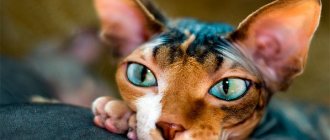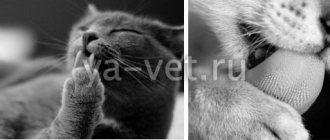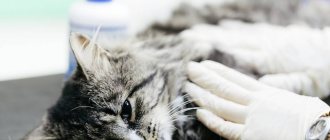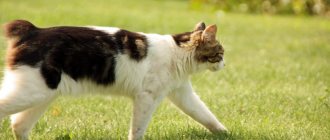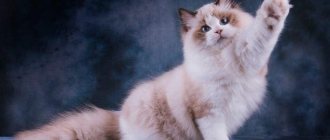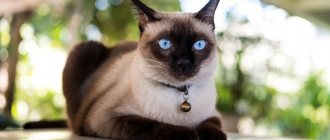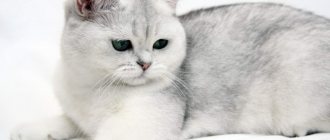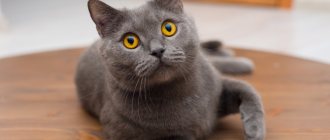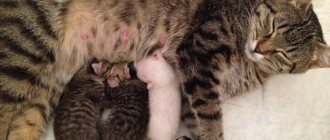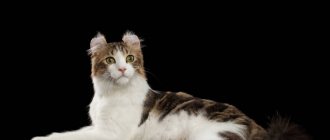From the history of the breed
Surprisingly, these animals are not the work of human hands. How hairless cats appeared, neither history nor science can give an exact answer. Scientists are inclined to believe that such unusual kittens are very rarely born to ordinary cats. This is due to a mutation in the gene that is responsible for fur.
The first information about these unusual animals came from Mexico in 1903. Later, mentions of them appeared in one or the other part of the world. Some animal lovers liked these affectionate and kind creatures. Therefore, experiments began to be carried out on crossing to obtain similar offspring. It cannot be said that all attempts were successful, but nature made sure that hairless cats survived as a breed. It continues to evolve, and perhaps soon we will see changed animals. Nowadays, hairless cats (the Sphynx breed) are divided into several types.
Hairless cat in the house: care features
Keeping a naked cat in the house is not as easy as it might seem. The hairless gene leaves a certain imprint on the character and behavior of the animal. Moreover, if some features are of a purely physiological nature, then the origins of others should be sought much deeper.
One can only guess about what problems owners of breeds that combine two or even three congenital pathologies may encounter. Therefore, it is not surprising that international felinological organizations are in no hurry to recognize the results of such experiments.
The myth that hairless cats are hypoallergenic
Those who believe that hairless cats are convenient and easy to keep because they do not shed and also do not cause allergies will be severely disappointed. Contrary to existing misconceptions, allergies are not caused by cat fur, but by specific proteins secreted by the animal’s endocrine glands. Modern science knows at least twelve “cat” allergens, which may be contained in:
- saliva;
- blood;
- urine;
- secretion secreted by the sebaceous glands;
- dandruff;
- top layer of skin.
Allergies to cats do not depend on the length of their fur
Wool is associated in our minds with allergies for two reasons:
- it easily transfers allergens that fall on it from the skin and from the saliva of an animal and, settling on various objects, causes a pathological reaction in us even at the moment when the animal has long left the premises (some allergens remain in the house for six months after leaving it). the cat disappeared);
- Wool accumulates dust, which is an independent and very dangerous allergen.
Thus, a hairless cat can cause allergies no less than a long-haired one.
Allergens are contained in the cat’s urine, saliva, and blood and come into contact with the skin, for example, during washing.
Problems with thermoregulation as a price for missing fur
Nature intended a cat to have fur. Bare skin causes serious discomfort to the animal, and as a result creates problems for the owner. There are four such problems:
- Hairless cats are constantly cold.
- Their skin is very sensitive to ultraviolet radiation and needs special protection.
- The lack of fur is compensated by an untidy and easily soiled brown coating on the pet’s skin.
- Hairless cats are hungry all the time.
These minor troubles combined make a hairless cat a very “inconvenient” pet, causing irritation in an unprepared person.
Lack of fur makes a cat's life very difficult
Cold protection
Enthusiastic stories about how many different blouses and fashionable overalls you can buy for your Sphynx do not actually solve the problem of a freezing cat. Clothing restricts the animal's movements and is perceived by it as an annoying hindrance.
Not all cats like to wear clothes
The cat prefers to escape the cold by climbing under a blanket, into clothes or another secluded place, sometimes spending almost its entire life there. Many owners complain that they see their Sphynx only in the kitchen, where the pet runs, heart-rendingly demanding food, and, having eaten, hides again in its nest.
Hairless cats are always looking for a warm nest
The vaunted affectionateness of hairless cats is also often due to the fact that the animal is simply trying to warm up by clinging to a person. The suspicion that this is precisely the price of the love of a hairless cat for its owner is expressed by many owners of these animals. This idea was expressed most vividly by my friend, noting that she could clearly read in the eyes of her Canadian Sphynx jumping onto her lap: “I hate you! But you're warm."
The statement that the body temperature of Sphynxes and other hairless cats is higher than that of “wool” breeds is incorrect. The feeling that the Sphinx’s body is too hot arises from the fact that when we touch the animal’s unprotected skin, we subconsciously compare the normal temperature for a cat, 38.0–39.5, with a human temperature and, accordingly, perceive it as elevated. When we pick up an ordinary cat, we touch its fur, not its skin, and do not feel the animal’s real body temperature.
Sun protection
Heat causes hairless cats just as much trouble as cold.
The owner of the Canadian Sphynx I mentioned, having suffered with her pet in cold Ireland, by the will of fate moved to live in Australia. She was happy with the thought that finally her favorite animal would stop freezing. But it was not there. Wanting to warm up, on the very first day the cat stretched out on the windowsill, exposing her sides to the gentle sun, and got so burned that she had to go to the veterinarian. Now the cat is generously lubricated with baby sunscreen every day, which clogs the pores and causes various dermatitis, acne and other skin problems that do not add health, happiness, or beauty to the animal.
The sphinx has delicate skin, which must be protected from direct sunlight: the animal can get sunburned, even sitting on the windowsill
Increased sweating
The lack of shedding in hairless cats is compensated by a much more unpleasant moment: protecting the skin from the aggressive effects of the external environment, the sebaceous glands of these animals produce a specific secretion, similar in texture to wax. Hence the untidy brown spots on the face, ears, belly, paws and other parts of the body of sphinxes. In addition to the fact that the cat looks unaesthetic, this waxy coating remains on literally everything the animal touches.
Hairless skin becomes covered with an uneven brown coating.
Not every housewife is ready to calmly accept dark, greasy stains on upholstered furniture and find the same marks on freshly washed bed linen. Although plaque can be removed from the skin quite easily, this procedure is a bad way out. The more often you clean, the more active the sebaceous glands work. The waxy substance is intended to protect the cat's bare skin, and attempts to remove it will aggravate the cat's well-being problems associated with the lack of hair.
Bathing is bad for any cat's skin
Constant hunger
Due to the almost continuous discomfort caused by the need to fight the cold, metabolic processes in the body of hairless cats proceed at an accelerated rate. As a result, the animal constantly wants to eat and cannot always stop in time. This, in turn, raises additional problems:
- tendency to obesity, which is dangerous for the cat’s health and, in the absence of hair, looks especially ugly;
- increased likelihood of digestive disorders (sphinxes, out of greed, are ready to swallow everything indiscriminately, while they have a weaker digestive system than other breeds).
The owner of a hairless cat is required to be very careful about what and how much his pet eats.
An overweight hairless cat looks disgusting.
State of health and the most common diseases
The lack of hair on a cat, which seems so attractive to someone, causes a lot of inconvenience to the animal itself. Unfortunately, the mutation that causes this feature is somehow associated with other health disorders. There are several diseases that Sphynx cats are more susceptible to than other cat breeds. Other breeds based on mutations also have related problems. By crossing such animals with sphinxes, we pass on to the offspring a predisposition to several groups of diseases at once.
A welcome exception to this rule is the American Curl. Genetic studies of the nature of the mutation that causes the unusual shape of the curl's ears confirm the absence of its connection with any other deformities and pathologies.
The list of the most common hereditary diseases of Sphynxes, Scottish Folds and Munchkins will help the potential owner of one or another variety of hairless cats to form their own opinion about the ethics of creating such breeds.
Eyes unprotected by eyelashes are one of the weak points of sphinxes.
Table: hereditary diseases characteristic of hairless cats and their ancestors
| Breed name | Characteristic pathologies |
| Sphinxes |
|
| Scottish fold | Osteochondrodysplasia (defect in the development of cartilage tissue). |
| Munchkin | Lordosis (weakening of the muscles that support the spine), as a result, improper functioning of all internal organs. |
Breed and its varieties
These animals lived in the palaces of Ancient Egypt. Then, for a very long time, people seemed to forget about them, but the most amazing thing is that they did not disappear, but spread across all continents. By the beginning of the twentieth century, hairless cats had already taken part in exhibitions. Today the following types of these cats are especially popular:
- Don Sphynx.
- Canadian Sphynx.
- Peterbald (Petersburg Sphinx).
- Elf.
- Ukrainian Levkoy.
- Kohona (Hawaiian hairless).
- Bambino.
What are the differences between these animals and do they exist? Let's get to know each other better.
Why are cats hairless?
The mentioned cats Nellie and Dick turned out to be relatives, which is probably why the owner did not breed the breed, although he gave the animals a detailed description.
By the middle of the 20th century, information about the appearance of kittens without fur began to appear in the media from different countries.
It is believed that a kitten named Prune from North America became the ancestor of the Canadian Sphynx. The Don Sphynx was registered in 1998; the wonderful cat Varvara is considered the ancestor. It became clear that new
horizons for breeding cats. They began to actively breed hairless cats after the 80s of the last century.
A mutation led to the appearance of bald purrs in the world - thanks to this genetic failure, which is hereditary, the world saw new breeds of cats.
Don Sphynx
This is one of the most common hairless cats. The breed did not receive its current name immediately. At first it was simply called the “Don cat”, then the name “Russian hairless” appeared. They even tried to call her “Russian trotter”, but, fortunately, this “name” did not stick.
Don Sphynxes, in turn, are divided into three types - bare-born, flock and brush. Cats are covered with deep wrinkles, and their skin is warm and soft to the touch. Most folds are concentrated in the head area, neck and groin. It is curious that newborn babies have curled whiskers. The breed standard allows for any color, but it is noteworthy that in this variety more often than in others, a black hairless cat is found.
Content Features
In some aspects, keeping a hairless cat is more difficult than a regular one, and in others it is easier. The advantage is, first of all, that owners of hairless cats do not need to regularly clean their apartment of hair. But the cat itself needs more care; it needs to be washed or wiped with wet wipes often.
Some people believe that hairless cats do not cause allergies. This is not entirely true, because allergies occur not only to wool, but also to saliva and skin secretions. But the claims that hairless cats are able to treat diseased joints are true. The skin of a hairless cat is very warm, and if you put your pet on a sore spot, noticeable relief will soon occur.
Hairless cats love to sleep on radiators. To prevent the animal from burning its skin, the batteries need to be covered with fabric covers, or it is better to buy a special cat hammock that is installed on the radiator.
Hairless skin is vulnerable to cold and direct rays of the sun, so you need to protect the animal from hypothermia and sunburn. The cat should have clothes for different seasons, and there should be no drafts in the house.
Canadian Sphynxes
The appearance of these cats is very attractive and unusual. The hairless cat, whose photo can be seen in all publications about these animals, has rounded and very smooth body lines. The body is completely hairless; it is covered only by numerous folds. This is especially noticeable in newborn kittens, and with age the folds decrease slightly.
The Canadian Sphynx has large beautiful eyes. Because of their extraordinary brilliance, this type of sphinx is sometimes called the “moon cat.” Canadian Sphynxes are recognized as one of the most beautiful cats in their breed.
Peterbald
The hairless Peterbald Sphynx cat is very similar in appearance to an ordinary Oriental cat, but without hair. And in this case, appearances are not deceiving. Peterbalds were bred by crossing the Don Sphynx with an Oriental cat. They have a narrow and elongated head, large almond-shaped eyes, a rather slender and slightly elongated body, long limbs and very neat paws.
For the most part, Peterbalds are friendly. They are smart, playful and very inquisitive. They do not strive for independence, and often even avoid it. Peterbalds get along well with children and quickly make friends among other pets. Thanks to this, these cats are very popular.
Mr. Cat recommends: personality traits of hairless cats
All cats without fur have a warm disposition and a pleasant character. Whether this was the result of experiments, or whether it was inherent in nature, many people compare such pets primarily with dogs, always faithful, devoted and affectionate. Very quickly becoming attached to the owner, they have a hard time with a change of environment or a long separation, or constant loneliness.
These are sociable cats, very smart and inquisitive. Some of them are able to carry small objects and are easy to train. They understand human speech well and the tone in which their owners speak to them. They love affection and give it in return.
The good nature of pets will come in handy if there are small children or other animals in the house.
Breed of hairless fold cats - Ukrainian Levkoy
This hairless cat, whose photo is often shown by breeders, was bred in Kyiv 10 years ago. They are the result of mating a Scottish Fold and a Don Sphynx. It must be said that these animals combine the characteristics of these two breeds. Levkoi are hairless, although the presence of a brush (small fluff) on the body is allowed.
The head, neck, groin and abdomen are covered with folds. They are not as pronounced as those of the Don Sphynx. They got their folded ears from the Scottish Fold. This gives the animals a very unusual appearance.
Sphynx cat breeds: description and characteristics
There are nine varieties of cats in the world that are classified as hairless breeds.
Canadian Sphynx
The history of the breed began with the birth of a kitten named Prune from an ordinary short-haired cat in 1966. Four years later, the breed was officially recognized, but soon it faced complete degeneration. However, in 1975, with the appearance of the hairless kitten Epidermis, its restoration began, and in 1979 the Canadian Sphynx was registered again.
The Canadian Sphynx has a large head, elongated towards the nose, large ears and beautiful sapphire eyes. The skin is dotted with “old woman” wrinkles.
These cats are not completely naked. They have a little hair on the muzzle, tail and paws, but no whiskers. It is assumed that they are genetically close to Mexican hairless cats.
Don Sphynx
The ancestor of the breed is considered to be a cat named Chita, born from Varvara, who began to go bald at six months, and a European shorthair cat. The first hairless kittens appeared after her mating with her son Hannibal. In 1996, the breed was registered.
Don Sphynxes come in flock, velor, brush and simply bald. They have not too large ears with sharp tips and almond-shaped eyes. Owners claim that their pets are so cute that they always make you smile.
Peterbald
The first representatives of the breed appeared by crossing the Don Sphynx and the Oriental. The selection was short-lived, and in 1996 the breed was already registered with the Breeding Felinological Federation.
Peterbalds have an oriental-type body with almost no folds, a long neck, and slanting eyes. Brush, velor or flock cover is often found. Some animals even have mustaches and eyebrows.
Elf
The breeders decided to take the Canadian Curl and the American Sphynx as the basis for the breed, but the efforts of the breeders led to success for a long time. The first kitten of a suitable phenotype was born only in 2006, 10 years after the start of work. Another year later, the standard was registered, but the improvement of the breed continues.
In body type, elves resemble Canadian sphinxes, but their ears are curved, like curls. They are considered a very expensive breed, the price of a kitten reaches up to $3,500.
Dwelf
Dwelf got its name from the words dwarf and elf. This is one of the most unusual breeds of hairless cats, which was obtained by crossing an Elf, a Bambino and a Canadian Curl. The selection lasted from 2007 to 2009, quickly producing results. Babies with short legs and curled ears were born. In addition, representatives of the breed always have fluff on their bodies.
Bambino
The breed resembles a dachshund with a long body and short legs. Nothing is known for certain about its origin, except for one thing: the bambino appeared after crossing a munchkin and a Canadian Sphynx. But whether the breed was bred through selective breeding or whether nature was just “playing around” is unclear.
Bambino (Italian: ambino-baby) are baby cats that weigh on average 2-3 kg. They have “bulging” eyes, which are quite often heterochromic, that is, different colors. The folds on the body are not very pronounced, and the color varies from white to dark, sometimes with spots.
Cohona
"Kohona" translates from Hawaiian as naked, undressed. Her homeland is Hawaii. The founder of the breed, the cat Cleopatra, was chosen from three hairless kittens left without a mother by veterinarian V. Smith. After crossing a cat with a Canadian Sphynx, she produced kittens of the appropriate phenotype. In 2002, the breed standard was approved.
The cojona's muzzle is wide and flat, the folds on the skin are not too deep, and are symmetrical. A distinctive feature of the breed is the complete absence of fur, eyebrows and eyelashes. All kittens are born completely naked, without a hint of brush or velor, with waxy skin. They remain like this all their lives.
Minskin
The breed originated in the American city of Boston. The breeder crossed a munchkin, a sphinx and short-legged cats with short hair. The result was kittens with folds and very short hair. The covering on the body resembles cashmere to the touch, and on the head and ears the fur is almost the same as that of ordinary short-haired cats.
Minskins are very affectionate and intelligent creatures. They love their owners and are always ready to play with children.
Ukrainian Levkoy
The beautiful name of the breed comes from the name of the flower - gillyflower. Its first representative, Levkoy Primero, appeared after crossing the Scottish Fold and the Don Sphynx.
The peculiarity of the breed is its massive body. The head has a wedge shape, which is decorated with charming hanging ears. The color is white, but can be in other shades.
Elf
If left-handed cats have ears that droop, like Scottish Folds, then the bald Sphynx cat of the elf variety has ears, the tips of which bend towards the back of the head. Thanks to them, the animals got their name.
Elves have no hair and are completely justified in their attitude towards hairless cats. They got this unusual appearance as a result of mating American Curls with Sphynxes. Work on this type of cat began at the beginning of the 20th century, however, these animals are not yet officially recognized.
Menu creation
Sphynxes are not picky eaters. If you watch cats feeding, you will notice that the pets look like hungry puppies. They throw food into their mouths so greedily and enthusiastically that they can even choke after swallowing an excessively large piece of food.
Sphynx cats eat both natural food and dry food. To avoid health problems, veterinarians recommend feeding your pets only natural ingredients. If owners are too busy, dry food will come to the rescue.
A bowl of water should be kept near the animal at all times. Lack of water leads to the development of urolithiasis in cats.
Bambino
Bambino cats look like small and funny dachshunds. This cat has a muscular and round body, a pointed muzzle, large pointed ears and large almond-shaped eyes.
These features and folds on the bambino’s body were awarded to the bald Sphynx cat (you see the photo in our article), and he received the shortened limbs from the munchkin. In this animal, the folds on the body are not so clearly expressed.
Despite their short legs, these cats are very agile, although it is quite difficult for them to climb onto high furniture. These are playful and sociable animals. Bambinos are distinguished by their original exterior, which will allow them to win the hearts of millions of cat lovers around the world in the near future.
Character and habits
Hairless cats are distinguished by their intelligence and high level of intelligence. Many owners agree that they understand every word. Sphinxes quickly remember simple commands and quickly get used to their name.
Hairless cats are happy to give their love and tenderness, but in exchange for reciprocity from the owner, which is typical for all domestic animals.
These animals are very sociable and loving, gravitate towards tactile contact with humans, become attached to the owner and have difficulty enduring loneliness, but are suspicious of crowds of unfamiliar people. Due to their sociability, they make excellent companions for children. Perhaps it is precisely because of their temperament that photographs of hairless cats kissing people are so common.
But their tenderness and devotion does not prevent many individuals from remaining wayward.
Sphinxes lead an active lifestyle, easily climb high objects, and love to follow their owner.
Despite these common features, each cat has its own character and temperament, which is certainly influenced by the atmosphere created around it.
Cohona
This cat is very similar to the Sphynx, although there are no family ties between them. Kohona arose naturally; man did not take part in its creation. She lives in Hawaii. Its name is translated from the local dialect as “bald”.
If Sphynxes have skin that feels like velvet to the touch, then Hawaiian hairless cats have more like melted wax. This is explained by the fact that representatives of this breed do not have hair follicles, which means that hair growth is impossible. Scientists have not yet established why and how this mutation arose.
Maintenance and care
So, we have introduced you to the common types of hairless cats. Agree, animals are unusual, and therefore their care should be special. Sphinxes are very hot to the touch. Their body temperature is 39-40 degrees. Kittens generally resemble a heating pad - their body temperature in some cases reaches 42 degrees.
For these animals, the temperature regime (20-25°C) and the complete absence of drafts are important. They love the sun very much, but it can be dangerous for them, as unprotected skin can get severely burned.
Care, hygiene and feeding
Skin secretions in hairless cats are more abundant in the area of the ears and fingers, so these parts of the body need to be wiped more often than others. To wash a hairless cat, you should use high-quality hypoallergenic shampoos with a mild detergent base. Shampoos should be for cats; human shampoos (including children's) are not suitable; they cause itching, dermatitis and dandruff in cats.
Hairless cats do not have hairs on their faces to protect their ears and eyes from dust, so these parts of the body quickly become dirty and need to be wiped periodically. Sphynx cats often have problems with teeth and gums, so they need complete oral care - brushing their teeth and massaging their gums.
How to wash a hairless cat?
This issue should be given special attention. Sphynx cats need to be bathed at least once every two weeks because these cats sweat. For this purpose, you should use special shampoos for hairless cats or baby soap. Don't worry that bathing will be unpleasant for your Scythe as it is for other breeds. Hairless cats love water activities, and many of them are first-class swimmers.
The history of hairless cats
Amazing hairless cats, unlike any other breed, were born due to a genetic failure . The recessive gene for hairlessness hr is inherited, so felinologists happily took on the task of breeding new breeds.
The cause of the hair loss has not yet been determined . There is probably a connection with single natural mutations that were supported by breeders to preserve the characteristic feature through selection. Some individuals are born completely bald, others have a small coat of fur on the tail, muzzle, and body, reminiscent of velor.
The first mentions of hairless cats date back to the times of the Aztecs . Evidence of such breeds has been found in Morocco, India, and Paraguay. In the 60s of the twentieth century. In Canada, French and Canadian felinologists teamed up to work on breeding the first hairless cats. Now this is the world famous Canadian Sphynx. A domestic cat in Toronto gave birth to a furless kitten named Prune. It was he who became the founder of the Canadian Sphynx, a breed recognized by international felinological organizations.
To obtain the next litter, Prune was crossed with his own mother - and hairless kittens were born in the litter again. In 1975, the situation repeated itself: in the USA, an ordinary cat gave birth to a furless kitten, which was named Epidermis. Gradually, the number of sphinxes increased, thanks to the crossing of rare individuals. By the way, Canadian Sphynxes often have residual hairs on the face, ears and tail, but in most cases, kittens are born naked and without whiskers.
Canadian Sphynxes are strong and muscular animals with a developed chest, slender and strong legs . Among the representatives of the breed there are often long-livers. Some individuals live up to 25-28 years.
In 1987, in Rostov-on-Don, Elena Kovaleva picked up an almost hairless baby. He only had fluff on his paws, tail, behind his ears and on his chest. The cat was named Varvara, and a couple of years later she gave birth to kittens from the mongrel cat Vasily. Surprisingly, the offspring included hairless kittens. Thus, the defect turned out to be a stable genetic mutation. From that moment on, the persistent and painstaking work of Russian felinologists began to create a new, unique breed. So, in 1998, the Don Sphynx received official recognition .
The oriental cat Radma Von Jagerhof took part in the development of the breed, and gave birth to the kittens Mandarin and Muscat, Nezhenka, and Nocturne. Subsequently, they transferred the genotype to the St. Petersburg Sphynx or Peterbald. The new breed was registered in 1996 as a representative of the Siamese-Oriental group. It differs from the ancestral breed in its graceful and fragile physique, lack of aggression and rancor towards humans.
Hygiene procedures and nutrition
Do not forget that the Sphynx needs to clean its ears and trim its claws so that it does not scratch itself. A naked cat needs an increased level of heat exchange, so it eats much more food than its “clothed” counterparts. And in winter, increase the caloric content of food.
The Sphynx's diet should include vegetables - carrots, cauliflower, beets, zucchini. The kitten must be accustomed to them from a very early age. Dairy products include cottage cheese, yogurt or kefir, a little cheese, which is added to porridge or vegetables, boiled meat and fish, and egg yolk.
Hairless breeds care
have no fur
very delicate skin that needs care and hygiene. Dirt often accumulates in the folds, so the skin is washed with baby shampoo. Surprisingly, many pussies are ready to splash around in a warm bath for hours. The owner’s task is to ensure that water does not get into the ears - you can stuff the ear canals with cotton wool. For a bath, the optimal water temperature is 36-38°C. A rubber mat is placed on the bottom - without it, a cat that slips will remember for a long time the offense against you and the whole wide world.
They take into account the dislike of hairless creatures for showers - you will have to wash off the shampoo with your palms.
If the cat has a pronounced reluctance to bathe, the bath is replaced by wiping with cotton pads soaked in lotions for baby skin.
If your pet sweats a lot, the discharge must be removed with cotton pads and lotion.
The skin may dry out excessively after contact with water, so it is recommended to lubricate it with baby oil.
Keeping hairless cats
If you want to buy a hairless cat, then it is important to understand that such pets should not be left to their own devices, they definitely need attention and good care. Their health needs constant monitoring, because wool will no longer serve as protection from external factors.
If you are a too busy person, then you should not make life difficult for either your pet or yourself - after all, both kittens of hairless cats and adults take up a lot of time.
Such an animal requires living in a warm place - they tend to freeze and do not have the opportunity, like other cats, to warm up under their own thick fur coat. Such pets can often be seen next to a radiator or heater. To prevent skin burns, caring owners place a thick cloth on the cat’s favorite place.
Carefully walking hairless cats
- the sun's rays can also burn the skin, and the absence of fur does not in any way protect the body from a shock dose of ultraviolet radiation. The time for walks is calculated so that the cat does not walk under the scorching sun.
Feeding
A good owner will treat the pet with care and will not allow it to receive less nutrients or eat low-quality food.
This article will tell you about the basics of proper nutrition for adult Sphynx cats and their offspring.
You can feed your pussy with industrial or natural food. The age of the cat is always taken into account: a different diet is suitable for kittens, as is the case for older individuals. Lactation, pregnancy, illness, castration play a big role.
The menu includes meat, skinless and boneless chicken breast, chicken offal, vegetables in any form, fruits, parsley. You can give steamed oatmeal, buckwheat or rice. Three times a week it is useful to feed your pussy with pharmaceutical brewer's yeast. Once a week, cheese and chicken yolk are included in the diet.
To cleanse your teeth, it is useful to add crackers to your food.
Character
Anyone who wants to have such a pet should know that the character of these animals is significantly different from ordinary cats. They are more like dogs in character. They prefer to choose their owner themselves and become boundlessly attached to him. Sphinxes do not tolerate loneliness; only those people who spend more time at home than outside should get them. If a hairless cat is given to other people even for a short time, he may become ill from boredom.
Hairless cats love children very much. Despite their somewhat frightening appearance, they are very affectionate and gentle creatures. They love to be petted, and sometimes it seems that they perfectly understand the owner’s speech.
Popular breeds
Today, the name “hairless cats” refers to several breeds of felines that differ from their relatives in the complete absence of hair. Mostly they are descendants of those cats that were first bred about 50 years ago.
But there is also a category of animals that differ in their own pedigree and characteristic features. They are mainly the result of a spontaneous genetic mutation during pregnancy in cats with a healthy coat. Next, we will take a closer look at the most popular breeds of this pet.
Did you know? Hairless cats can sunbathe in the sun, just like humans. However, this process must be strictly monitored so that their delicate skin does not get burned.
Canadian Sphynx
One of the most prominent representatives of the so-called hairless cat breeds is the Canadian Sphynx.
This animal is considered to be the ancestor of modern cultivation of hairless felines, so its history goes back more than 50 years. Cats are characterized by a complete absence of fur, the slightest manifestation of which is unacceptable, but short fluff in the nose area is still present. Cats of this breed are graceful in movement.
Their tail is long and thin, curled into a small ring, which is often pressed to the body. The belly is round and pear-shaped. The front legs are much shorter than the hind legs, which is the reason for the rather unusual but characteristic gait. The leather is pleasant to the touch, thick, and looks like suede.
Learn more about the intricacies of cat care: how to mate, make a scratching post, choose a carrier and sterilize a cat.
On the stomach and neck, the skin is distinguished by the appearance of small sweet spots. The ears of such cats are large, their tips are rounded. The breed exhibits clear sexual dimorphism - males are larger in size than females, so the average weight of a cat is approximately 5 kg, while cats weigh about 3.5 kg. The character is affectionate, calm, there is affection for the person.
Petersburg Sphynx (Peterbald)
The St. Petersburg Sphynx was bred in Russia in 1994, and 2 years later it was recognized by the SFF. The breeding of this animal is the result of the painstaking work of many well-known felinologists in Russia.
Peterbalds are quite elegant cats; they are sophisticated, quite slender and have a characteristic elongated head and body shape . The eyes are large, almond-shaped, ears are spread to the sides.
The ideal Peterbald is an exact hairless copy of Oriental cats. The St. Petersburg Sphynx has a calm, friendly and affectionate character; they are curious about the world around them and are quite intelligent.
Did you know? All cats retract their claws when at rest, with the exception of the cheetah.
Don Sphynx
The Don Sphynx is one of the cats whose history begins in 1986. The animal is the product of a spontaneous mutation, the genotype of which was successfully preserved. It has an expressive muzzle with large, almond-shaped and slightly slanted eyes and large ears.
This breed of hairless cat has a slender, muscular body and paws, long toes and a tail. The breed standard allows both a complete absence of hair and its presence in small quantities.
The Don hairless Sphynx cat is characterized by great affection for its owner , affectionate and kind character and a complete lack of aggression towards others. This animal is very playful, however, discreet and unobtrusive.
Bambino
The Bambino is an experimental Sphynx breed that was created in the United States by crossing a typical hairless cat and a Munchkin. There is no hair on the body at all, but a small amount of hair is acceptable.
The size of the cat is quite miniature, so adult individuals do not exceed a weight of 4 kg (on average - about 3 kg). This type of cat is characterized by short legs and a strong, muscular body. The body is elongated, oval in shape, so the cat is very similar in shape to a dachshund.
But its body is much shorter, and its tail is thin and long. The size and shape of the head are typical for sphinxes, the eyes are green, gray or yellow, the ears are large, triangular in shape, rounded at the top point. Despite the very high prevalence of the bambino, the cat is not yet officially recognized.
Important! Bambino requires special care. This is due to the fact that this type of cat is characterized by a wrinkled forehead, in the folds of which dirt accumulates, so the cat’s face must be constantly cleaned to avoid the development of skin infections.
Devon Rex
The Devon Rex is a species of animal that was born as a result of a natural change in its genotype. The breed originates in the second half of the twentieth century.
In the UK, Devonshire, local residents identified several wild kittens with a characteristic reduced amount of fur. Over time, persistent genetic traits were developed that allowed this animal to join the list of unusual pets.
As a rule, Devon Rexes are small animals whose weight does not exceed 4 kg. Cats' fur is quite short and fluffy, and its length does not exceed a few millimeters. Therefore, they are often classified as hairless cats. Their body is powerful, with pronounced muscles, their legs are long and thin.
Many owners prefer such foods as Purina, Hills, Kitekat, Royal Canin for their pets.
The head is small, with a clear profile. The ears are large, low set, with a distinct rounding at the tips. The eyes are oval and large. Like the rest of the cats in the group, Devon Rex cats are distinguished by their kindness, affectionate and playful disposition, as well as a real curiosity about everything around them and what is happening.
Cornish Rex
The Cornish Rex is a group of short-haired cats that are often classified as hairless Sphynx cats. The breed began more than 50 years ago. At this time, in the UK, in the county of Cornwall, as a result of a natural gene mutation, a kitten appeared on whose skin there was no guard hair at all.
Through independent selection of local residents, this genotype was quite successfully preserved, which resulted in the emergence of a new variety of domestic cats. According to the official description, these breeds are characterized by an almost complete absence of guard hairs on the skin (with the exception of a light undercoat). The head of these cats is small, wedge-shaped, and its shape provides a rather unique full face and profile of the animal.
The eyes are predominantly large, oval in shape, the ears are large, pointed at the tips. The body of the representatives of the breed is powerful and muscular, however, small in size. The weight of an average cat is within 4.5 kg, and that of a female cat is 3 kg. The paws are thin and graceful, which is the key to an easy and graceful gait.
Important! Cornish Rex cats are prone to overeating, so if you decide to get this cat, be prepared to constantly monitor the amount of food it eats. Otherwise, the animal will become obese, which threatens it with serious subsequent health problems.
Ukrainian Levkoy
A breed whose breeding began on the territory of Ukraine in the early 2000s. In 2004, the first offspring were born. However, today the breed is not yet recognized by the international community. Unlike its relatives, the main highlight of the cat is its folded ears. This was achieved by borrowing a genetic trait from the Scottish Fold cat.
A typical Ukrainian Levkoy has a flat, angular head and an elongated, thin, muscular body. The front and hind legs are slender and long. The eyes are large and slightly pointed.
On the skin, hair may be completely absent or appear as a light, barely noticeable undercoat. The skin is characterized by rather strong folding. Levkoy has quite highly developed sexual dimorphism: males are predominantly much larger than females.
Likoy
Likoi is one of the youngest varieties of hairless cats, which dates back to 2010, after American Patty Thomas from Virginia first decided to breed this animal.
Lykoi have no or almost no hair. This trait is a spontaneous mutation that occurred in a normal domestic cat. Lykoys are characterized by a wedge-shaped head with a slight roundness, which originates in the nose and extends to the cheeks.
large and wide, rounded at the top, the eyes are large, similar in shape to a walnut. The cat's body is muscular, slender, its paws are medium long, shorter than the body. The tail is much shorter than the body, cone-shaped with a pointed tip.
Did you know? A cat can jump up to 5 times its own height.
Names
If you have a Sphynx, then you are probably wondering what to name a hairless cat. Names for purebred sphinxes should be selected taking into account some of their characteristics. If you bought a kitten from a cattery, look at its documents. Some breeders name the newborns themselves, while others indicate in the documents only the letter with which the cat’s name should begin. For example, if the letter K is indicated in the metric, then names such as Cassiopeia, Clarissa, Cassandra, etc. are suitable for your cat.
The cat can be called by a name from Egyptian history or mythology. The most suitable nicknames are Osiris, Set, Yachnus. And for a royal cat the name Cleopatra or Nefertiti, Isis or Bastet, etc. would be suitable.
Remember that cats remember best nicknames that contain the sound K and hissing sounds. That’s why they react this way to the traditional “kiss-kitty.” If such sounds are present in the name, and it is no longer than two syllables, the baby will instantly learn it.
How to choose the right kitten, cost
It is recommended to buy kittens in nurseries; in this case, you will receive documents with a pedigree and a medical card with a list of previous diseases and vaccines. When choosing a kitten, focus on its parents and living conditions. If the breeder does not take care of the wards, this can cause diseases in the future. Assess your baby's appearance, behavior and playfulness.
The cost of purebred pet-class animals starts from 10 thousand rubles, a show-class animal can be found on sale for 150 thousand.
Intelligence
Sphinxes are easy to train. Their memory and developed sense of simple logic are very similar to dogs. They can bring small objects to their owner in their teeth, perform quite complex tricks, can open doors, etc. The sphinx is easy to train. They are not at all annoyed by walks on a leash. They are very sociable and curious by nature, and therefore socialize easily.
Their habits and character give their owners pleasure - the sphinx will watch TV with you and follow you around the apartment, wanting to be the center of attention.
